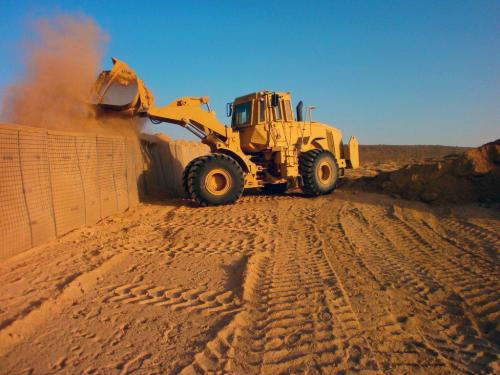Afghanistan: National Guard members with ‘Task Force Mad Dog’ leave their mark in Afghanistan (Part Ι)
Army Spc. Christopher Taylor stood huddled with other Soldiers in his platoon on the flight line, trying to make himself as small as possible while icy wind from the Chinook’s dual rotary blades blasted over him like the breath of a frost demon.

South Dakota Army National Guard Spc. Kyle Griffith of the 842nd Horizontal Construction Company fills barricades at Combat Outpost Giro. Giro was so isolated from the rest of the project sites it had to be resupplied by helicopter.
It was the middle of the night Nov. 28, 2011; the beginning of the coldest winter Afghanistan had seen in the last 15 years.
Four hours earlier, Soldiers from the 1022nd Vertical Construction Company didn’t know they would be going anywhere, let alone moving out in the middle of the night to a small combat outpost most of them had never heard of.
The order had come down; the entire company packed and got ready to move, and now stood shivering on a flight line in freezing temperatures.
Helicopters hovered and landed, barely visible in the darkness but easily identified due to thunderous reports of icy wind and screaming engines. The crew chief for the bird closest to them waved his hand back and forth, signaling them to board the aircraft. “Operation Devil Hammer” had begun.
“All I could think was ‘Where are we going, what is the security, what are the living conditions going to be like?’” Taylor said. “This is what I had always thought the Army would be like, but more time to plan would have been nice.”
In Afghanistan, Regional Command East supports the Afghan government by maintaining stability and freedom of movement along the border with Pakistan. Maintaining critical supply routes and preventing the influx of insurgents from the infamous Pashtu mountains dominated operations on the eastern-most boundaries.
On the western side of RC-East, away from the border, is Afghanistan’s Highway 1, aka “The Ring Route.” Built during the Soviet occupation, the Ring Route traverses the entire country in a circular fashion connecting most of Afghanistan’s major cities. The stretch of Highway 1 within RC-East links Kabul to Kandahar, key terrain for the sustainment and prosperity of the country as a whole.
In a landlocked nation with no ports and few functioning airfields, control of the road network equals control of the country. Coalition forces know this, the insurgents know this. The battle along Highway 1 speaks for itself.
In order to silence the insurgent network along Highway 1 for good, an additional brigade from the global reaction force was being brought in to attack the insurgent networks and flush the enemy out of their holes. Enter the 1st Brigade Combat Team, 82nd Airborne Division, the unit selected for the job.
Known as “Task Force Devil,” the 1st BCT was scheduled to arrive in theater just as the final snows of winter were melting. Their mission: run wild along Highway 1 throughout the fighting season, attacking the insurgent networks. Before this could be accomplished, they would need a home.
National Guardsmen from the 578th Engineer Battalion, Task Force Mad Dog, had been in country less than two weeks when this mission was materializing. Originally from Manhattan Beach, Calif., the 578th Engineer Battalion commanded two construction companies, four route clearance companies, and one forward support company.
They were given the daunting task of constructing five combat outposts and expanding three forward operating bases simultaneously. This was to be the largest single construction effort in regional history. TF Devil needed its bases operational when it hit the ground. TF Mad Dog had to execute in the dead of winter, with supply routes closing and aerial operations diminishing.
Operation Devil Hammer, preparing the region for an additional brigade combat team, could not fail.
Initially, TF Mad Dog had two construction companies. The 1022nd Vertical Construction Company from the Louisiana National Guard consisted of carpenters, plumbers and electricians and the 842nd Horizontal Construction Company from the South Dakota National Guard consisted of equipment operators for all varieties of construction equipment.
The sheer magnitude of Operation Devil Hammer required engineer units from all over Afghanistan to descend on the project, all under the command and control of TF Mad Dog.
Before the mission was complete, TF Mad Dog would have tactical control of the 236th Vertical Construction Company from the Texas National Guard, the 661st Horizontal Construction Company from the Illinois National Guard, the 577th Expeditionary Prime Beef Squadron Air Force construction organization and two tactical infrastructure construction teams from the 22nd Naval Construction Regiment.
Source: U.S. National Guard
- 405 reads
Human Rights
Fostering a More Humane World: The 28th Eurasian Economic Summi

Conscience, Hope, and Action: Keys to Global Peace and Sustainability

Ringing FOWPAL’s Peace Bell for the World:Nobel Peace Prize Laureates’ Visions and Actions

Protecting the World’s Cultural Diversity for a Sustainable Future

Puppet Show I International Friendship Day 2020

